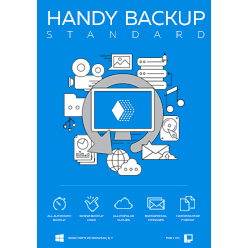WebDAV Web Folder
WebDAV, an extension to the HTTP protocol, allows creating Web folders that can be collaboratively used by multiple users simultaneously. This protocol supports multi-threaded file transferring and thereby provides a convenient means to organize team work without using specialized software. However, due to its “collective” nature, all data stored in WebDAV Web folders is strongly subject to accidental corruption by user mistakes.
Handy Backup provides an easy and reliable way to back up WebDAV web folders, or, vice versa, store backups to WebDAV. The former feature is especially powerful when you enable timestamps and keep multiple revisions of files.
Mapping WebDAV Web Folders
The process of creation of WebDAV folders depends on a specific environment. For example, Microsoft’s Windows Vista/XP, or Mac OS X of version 10.0 (and higher) have built-in WebDAV clients which, provided with fast connection, allow managing remote files as easy as files stored locally. For other operating systems there are alternative software solutions.
Since our software is primarily designed for use in Windows OS, the below instructions on mapping WebDAV web folders in Windows XP/Vista must be helpful for the majority of our users.
Mapping WebDAV Folders in Windows 8/7
To map a WebDAV folder in Windows 7 or Windows 8, follow these steps:
- Right-click Computer (using the Desktop shortcut or through the Start menu), and then click Map Network Drive.
- In the Folder field, specify the desired WebDAV URL.
- Since in most cases you will connect to WebDAV using other username and password than your Windows user, check Connect using different credentials.
- Click Finish.
- When prompted, enter your login and password, and then click OK.
Then you can use the newly mapped WebDAV folder as a source or destination for backups with our software.
Mapping WebDAV Folders in Windows Vista
To map a WebDAV folder in Windows Vista, follow these steps:
- Right-click Computer (using the Desktop shortcut or through the Start menu), and then click Map Network Drive.
- Click Connect to a Web site that you can use to store your documents and pictures, and then click Next.
- Click Next.
- Click Choose a custom network location, and then click Next.
- In the Internet or network address field, specify the desired WebDAV URL.
- When prompted, enter your login and password, and then click OK.
Mapping WebDAV Folders in Windows XP
The most convenient way of mapping a WebDAV folder in Windows XP is creating a Network Place shortcut for later use as a common folder. To do it, follow these steps:
- Open My Network Places (using the Desktop shortcut or through the Start menu).
- In the Network Tasks pane, click Add a network place.
- Click Next.
- Select Choose another network location, and then click Next.
- In the Internet or network address field, specify the desired WebDAV URL.
- When prompted, enter your login and password, and then click OK.
Using WebDAV to Access Cloud Storage
At present, we’re developing two new plug-ins that will allow you to use our program as a “WebDAV bridge” to popular cloud storage services. Please see the following pages for more details:
What to Back Up
How to Backup Documents on Computer - one-click backup of the My Documents folder including pictures, videos, music, and text files.
Website Backup - most reliable solution to protect your business web representation
Disk Image Backup - back up your hard drive by creating a hard drive image and saving it to the storage medium
MySQL Backup - simple, comprehensive backup of the MySQL database tables
Database Backup Tools - discover database backup solutions supporting various database management systems, including MySQL, MS SQL Server, and others.
Where to Back Up
Backup to DVD-R - record your backups to DVD-R with our in-built DVD burning tool
Backup USB - back up your data to any USB connected device such as USB flash key
Backup to FTP - transfer your backups to remote FTP server for more data security
Related Pages
Backup Mapped Drives - learn how to solve the problem of inability to backup mapped drives even if they are visible on a desktop
